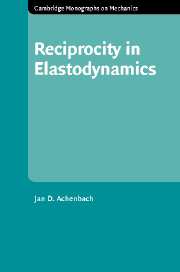Book contents
- Frontmatter
- Contents
- Preface
- 1 Introduction
- 2 Some elastodynamic theory
- 3 Wave motion in an unbounded elastic solid
- 4 Reciprocity in acoustics
- 5 Reciprocity in one-dimensional elastodynamics
- 6 Reciprocity in two- and three-dimensional elastodynamics
- 7 Wave motion guided by a carrier wave
- 8 Computation of surface waves by reciprocity considerations
- 9 Reciprocity considerations for an elastic layer
- 10 Forced motion of an elastic layer
- 11 Integral representations and integral equations
- 12 Scattering in waveguides and bounded bodies
- 13 Reciprocity for coupled acousto-elastic systems
- 14 Reciprocity for piezoelectric systems
- References
- Index of cited names
- Subject index
5 - Reciprocity in one-dimensional elastodynamics
Published online by Cambridge University Press: 10 December 2009
- Frontmatter
- Contents
- Preface
- 1 Introduction
- 2 Some elastodynamic theory
- 3 Wave motion in an unbounded elastic solid
- 4 Reciprocity in acoustics
- 5 Reciprocity in one-dimensional elastodynamics
- 6 Reciprocity in two- and three-dimensional elastodynamics
- 7 Wave motion guided by a carrier wave
- 8 Computation of surface waves by reciprocity considerations
- 9 Reciprocity considerations for an elastic layer
- 10 Forced motion of an elastic layer
- 11 Integral representations and integral equations
- 12 Scattering in waveguides and bounded bodies
- 13 Reciprocity for coupled acousto-elastic systems
- 14 Reciprocity for piezoelectric systems
- References
- Index of cited names
- Subject index
Summary
Introduction
For practical purposes much interest exists in the analysis of wave motion in elastic bodies that are geometrically defined by one or two large length parameters and at least one small length parameter. Examples are plates, beams and rods. The exact treatment by analytical methods of wave motion in such structural components is often very difficult, if not impossible. For that reason several one- or two-dimensional models that provide approximate descriptions have been developed. These models are based on a priori assumptions with regard to the form of the displacements across the smaller dimension(s) of the component, generally in the cross-sectional area. For beams and rods the assumptions simplify the description of the kinematics to such an extent that the wave motions can be described by one-dimensional approximate theories. For the propagation of time-harmonic waves it was found that the approximate theories can account adequately for the dispersive behavior of at least the lowest mode of the exact solution over a limited but significant range of wavenumbers and frequencies.
One of the best-known examples is the Bernoulli–Euler beam theory. In this simplest model for the description of flexural motions of beams of arbitrary but small uniform cross section with a plane of symmetry, it is assumed that the dominant displacement component is parallel to the plane of symmetry. It is also assumed that the deflections are small and that the cross-sectional area remains plane and normal to the neutral axis.
- Type
- Chapter
- Information
- Reciprocity in Elastodynamics , pp. 70 - 89Publisher: Cambridge University PressPrint publication year: 2004

